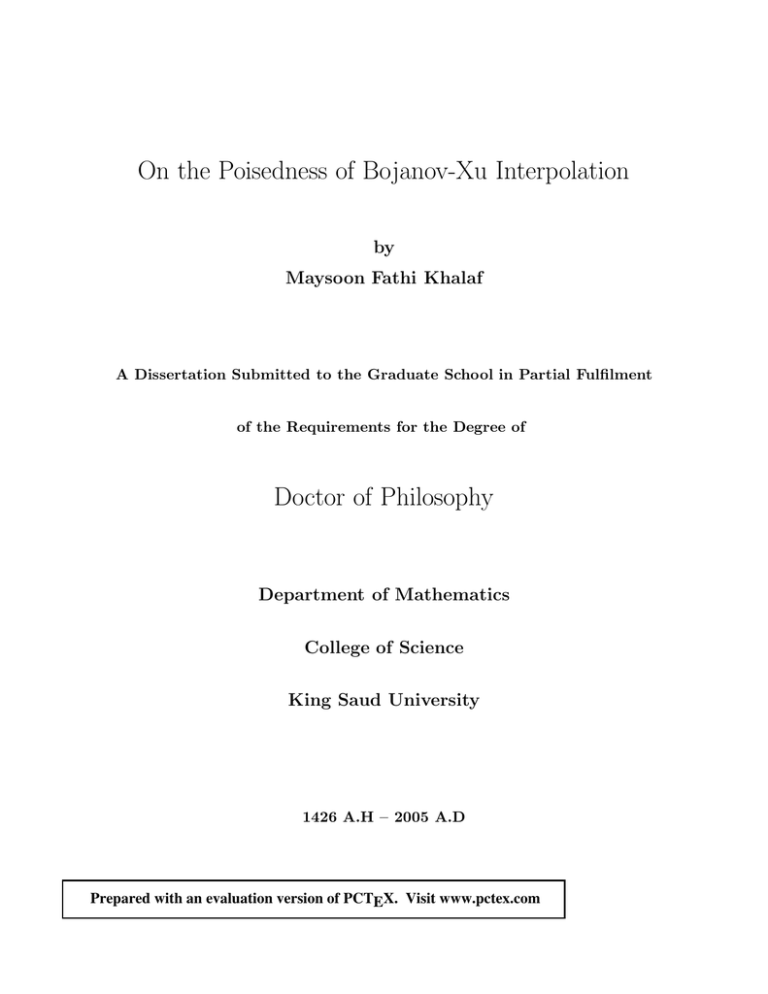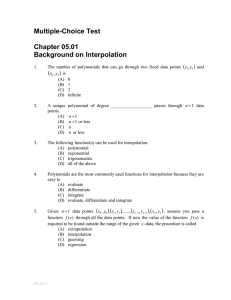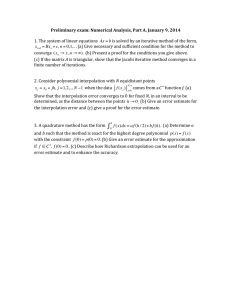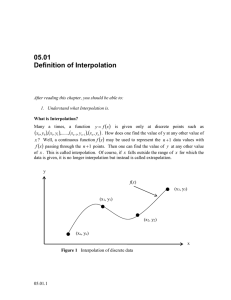Deanship of Graduate Studies: Home Page
advertisement

On the Poisedness of Bojanov-Xu Interpolation by Maysoon Fathi Khalaf A Dissertation Submitted to the Graduate School in Partial Fulfilment of the Requirements for the Degree of Doctor of Philosophy Department of Mathematics College of Science King Saud University 1426 A.H – 2005 A.D Prepared with an evaluation version of PCTEX. Visit www.pctex.com On the Poisedness of Bojanov-Xu Interpolation Ph.D. Thesis Submitted by Maysoon Khalaf Summary The bivariate interpolation discussed here was introduced by B. Bojanov and Y. Xu in 2002. Their approach is exceptional from some points of view. First of all the poisedness of this interpolation can not be established as readily as in the most cases in multivariate interpolation, i.e., by a simple use of Bezout’s theorem. Next, this is a unique case of bivariate (multivariate) interpolation where a result in Birkhoff context was obtained. The nodes of this interpolation are the points of intersection of 2k+1 distinct rays from the origin with a (multi)set of concentric circles, centered at the origin. The interpolation parameters are the values of a function and its radial derivatives up to the order µ − 1, where µ is the multiplicity of the node. The poisedness of this interpolation problem was proved only for the set of equidistant basic nodes and its counterparts with other conic sections. In this thesis many results, such as on poisedness, factorization, and Birkhoff context, are extended from equidistant node set to a wide family of node sets. Chapter 1 contains the main result concerning the evaluation of the generalized Vandermonde determinant of the Bojanov-Xu interpolation. On this basis, in Chapter 2 is proved that the poisedness of this (k + 1 − δ)(2k + 1) dimensional Hermite interpolation problem is equivalent to the poisedness of certain much simpler 2k + 1 dimensional Lagrange interpolation problems. Then the poisedness of Bojanov-Xu interpolation for a wide family of sets of basic nodes B lying on conic sections (ellipses, hyperbolas, and pairs of parallel lines) centered at the origin and satisfying some simple condition, so called opposite node property, is established. These results hold also with above circles replaced by ellipses, hyperbolas, and pairs of parallel lines. In Chapter 3 the poisedness relation between the Bojanov-Xu interpolation and certain lacunary algebraic and trigonometric interpolations is discussed. In Section 3.1 a conjecture concerning a poisedness relation between the Bojanov-Xu interpolation, with set of rays symmetric about x−axis, and certain univariate lacunary interpolations is established. Then the poisedness for a wide class of lacunary algebraic interpolations is obtained. In Section 3.2 it is shown that the poisedness of this bivariate Hermite interpolation problem is equivalent to the poisedness of certain lacunary trigonometric interpolation problems, this time without a restriction on the set of basic nodes B ⊂ C2◦ . This answers affirmatively a question of B. Bojanov and Y. Xu, who also established some special cases. In Section 3.3 it is proved that these trigonometric interpolations are equipoised with certain pairs of lacunary algebraic interpolations whenever the knots are symmetric about the origin. Next in Chapter 4 it is shown that the factorization result, connected with the Bojanov-Xu interpolation, holds in the case of general nodes and multiset of concentric conic sections if and only if certain Lagrange interpolations are poised. In particular the factorizations hold if the respective Bojanov-Xu interpolation is poised. In the last Chapter 5, for two versions of radial derivative, a result of B. Bojanov and Y. Xu on the poisedness of Bojanov-Xu interpolation considered in the context of Birkhoff interpolation is extended from the case of equidistant nodes to the general case. Prepared with an evaluation version of PCTEX. Visit www.pctex.com




